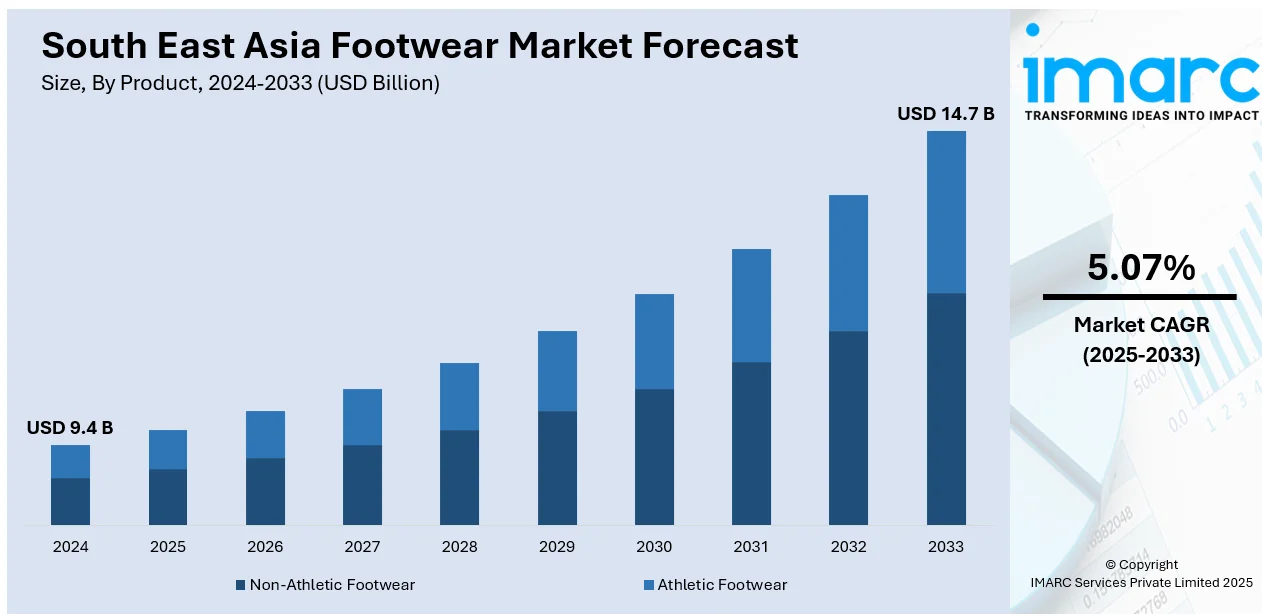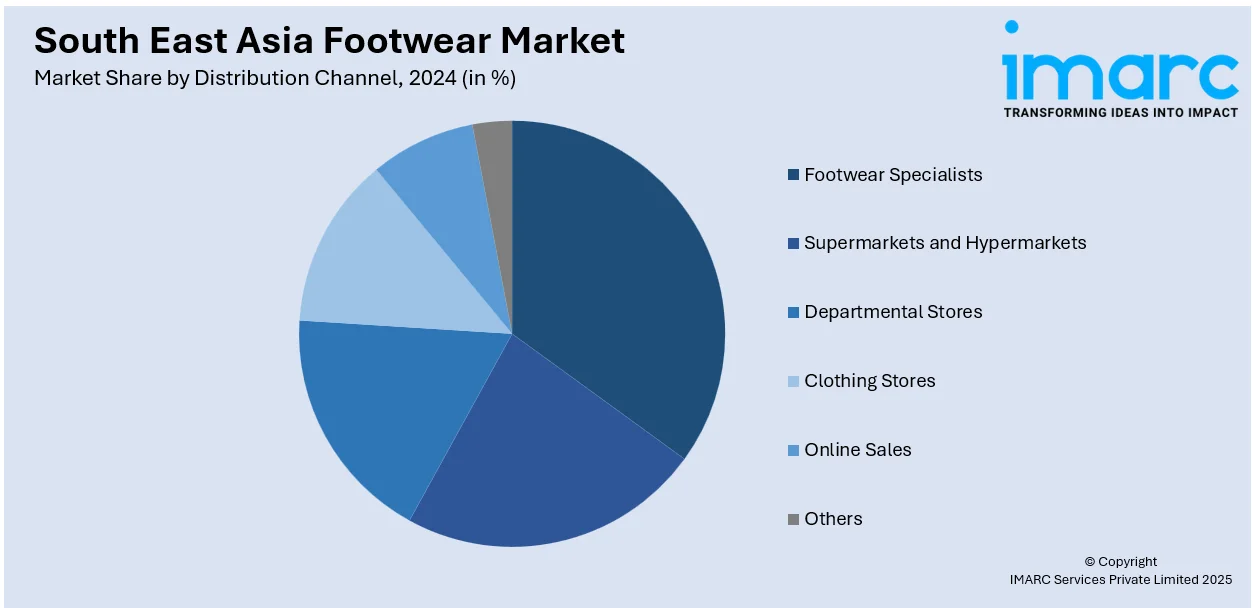
South East Asia Footwear Market Size, Share, Trends and Forecast by Product, Material, Distribution Channel, Pricing, End User, and Country, 2025-2033
Market Overview:
South East Asia footwear market size reached USD 9.4 Billion in 2024. Looking forward, IMARC Group expects the market to reach USD 14.7 Billion by 2033, exhibiting a growth rate (CAGR) of 5.07% during 2025-2033. The growing number of people willing to spend on premium shoes, increasing integration of 3D printing for the customization of shoes based on individual foot measurements, and rising demand for transparency in the supply chain represent some of the key factors driving the market.
|
Report Attribute
|
Key Statistics
|
|---|---|
|
Base Year
|
2024
|
|
Forecast Years
|
2025-2033
|
|
Historical Years
|
2019-2024
|
|
Market Size in 2024
|
USD 9.4 Billion |
|
Market Forecast in 2033
|
USD 14.7 Billion |
| Market Growth Rate 2025-2033 | 5.07% |
Footwear refers to protective coverings worn on the feet to support and provide comfort while walking, running, or engaging in various activities. It comprises athletic footwear, which is designed for sports and physical activities, including running shoes, basketball shoes, and soccer cleats. It also consists of casual footwear like sneakers, loafers, and sandals, which are ideal for everyday wear. Additionally, it includes formal footwear like dress shoes and oxfords, which are suitable for formal events and office settings. It also encompasses outdoor footwear, including hiking boots, waterproof boots, and trail shoes, which are essential for outdoor adventures. It can prevent foot problems, alleviate pain, and improve overall foot health. It is a critical safety measure in various professions and activities, protecting against workplace hazards and outdoor dangers. It enhances the quality of life by reducing discomfort and fatigue during daily activities. It helps maintain good posture by providing adequate support to the feet, which can extend to the entire body. It can boost confidence and contribute to the personal style of an individual.

To get more information on this market, Request Sample
South East Asia Footwear Market Trends:
At present, changing lifestyle preferences of individuals and the increasing number of people willing to spend on premium and innovative footwear are driving demand for high-quality and fashion-forward products in South East Asia. Besides this, innovative materials and advanced manufacturing processes are redefining the design, production, and marketing of footwear. The integration of 3D printing allows for the customization of shoes based on individual foot measurements, enhancing comfort and lowering the environmental impact of overproduction. Additionally, smart footwear equipped with sensors and connectivity features is gaining traction in region. Apart from this, brands are increasingly adopting eco-friendly materials, such as recycled plastics and cotton, to reduce their carbon footprint. Moreover, there is a rise in the demand for transparency in the supply chain, with people seeking ethically produced and cruelty-free footwear options. Additionally, the convenience of online shopping, coupled with an extensive range of choices offered by e-commerce platforms, is encouraging individuals to purchase the appropriate footwear online. This shift is compelling established brands to strengthen their online presence and engage in direct-to-consumer (D2C) models, bypassing intermediaries and adapting to the changing retail landscape. Furthermore, cultural influences and fashion preferences unique to each region are shaping the design and marketing strategies of footwear brands. Furthermore, the increased emphasis on comfort and functionality in footwear choices is bolstering the market growth in the region.
South East Asia Footwear Market Segmentation:
IMARC Group provides an analysis of the key trends in each segment of the market, along with forecasts at the regional and country levels for 2025-2033. Our report has categorized the market based on product, material, distribution channel, pricing, and end user.
Product Insights:
- Non-Athletic Footwear
- Athletic Footwear
The report has provided a detailed breakup and analysis of the market based on the product. This includes non-athletic footwear and athletic footwear.
Material Insights:
- Rubber
- Leather
- Plastic
- Fabric
- Others
A detailed breakup and analysis of the market based on the material have also been provided in the report. This includes rubber, leather, plastic, fabric, and others.
Distribution Channel Insights:

- Footwear Specialists
- Supermarkets and Hypermarkets
- Departmental Stores
- Clothing Stores
- Online Sales
- Others
The report has provided a detailed breakup and analysis of the market based on the distribution channel. This includes footwear specialists, supermarkets and hypermarkets, departmental stores, clothing stores, online sales, and others.
Pricing Insights:
- Premium
- Mass
A detailed breakup and analysis of the market based on the pricing have also been provided in the report. This includes premium and mass.
End User Insights:
- Men
- Women
- Kids
The report has provided a detailed breakup and analysis of the market based on the end user. This includes men, women, and kids.
Country Insights:
- Indonesia
- Thailand
- Singapore
- Philippines
- Vietnam
- Malaysia
- Others
The report has also provided a comprehensive analysis of all the major regional markets, which include Indonesia, Thailand, Singapore, Philippines, Vietnam, Malaysia, and Others.
Competitive Landscape:
The market research report has also provided a comprehensive analysis of the competitive landscape. Competitive analysis such as market structure, key player positioning, top winning strategies, competitive dashboard, and company evaluation quadrant has been covered in the report. Also, detailed profiles of all major companies have been provided. Some of the key players include:
- Adidas AG
- Anta Sports Products Limited
- Bata Corporation
- Fila
- Nike Inc.
- Puma SE
- World Balance
(Please note that this is only a partial list of the key players, and the complete list is provided in the report.)
South East Asia Footwear Market Report Coverage:
| Report Features | Details |
|---|---|
| Base Year of the Analysis | 2024 |
| Historical Period | 2019-2024 |
| Forecast Period | 2025-2033 |
| Units | Billion USD |
| Scope of the Report | Exploration of Historical Trends and Market Outlook, Industry Catalysts and Challenges, Segment-Wise Historical and Future Market Assessment:
|
| Products Covered | Non-Athletic Footwear, Athletic Footwear |
| Materials Covered | Rubber, Leather, Plastic, Fabric, Others |
| Distribution Channels Covered | Footwear Specialists, Supermarkets and Hypermarkets, Departmental Stores, Clothing Stores, Online Sales, Others |
| Pricings Covered | Premium, Mass |
| End Users Covered | Men, Women, Kids |
| Countries Covered | Indonesia, Thailand, Singapore, Philippines, Vietnam, Malaysia, Others |
| Companies Covered | Adidas AG, Anta Sports Products Limited, Bata Corporation, Fila, Nike Inc., Puma SE, World Balance, etc. |
| Customization Scope | 10% Free Customization |
| Post-Sale Analyst Support | 10-12 Weeks |
| Delivery Format | PDF and Excel through Email (We can also provide the editable version of the report in PPT/Word format on special request) |
Key Questions Answered in This Report:
- How has the South East Asia footwear market performed so far and how will it perform in the coming years?
- What is the breakup of the South East Asia footwear market on the basis of product?
- What is the breakup of the South East Asia footwear market on the basis of material?
- What is the breakup of the South East Asia footwear market on the basis of distribution channel?
- What is the breakup of the South East Asia footwear market on the basis of pricing?
- What is the breakup of the South East Asia footwear market on the basis of end user?
- What are the various stages in the value chain of the South East Asia footwear market?
- What are the key driving factors and challenges in the South East Asia footwear?
- What is the structure of the South East Asia footwear market and who are the key players?
- What is the degree of competition in the South East Asia footwear market?
Key Benefits for Stakeholders:
- IMARC’s industry report offers a comprehensive quantitative analysis of various market segments, historical and current market trends, market forecasts, and dynamics of the South East Asia footwear market from 2019-2033.
- The research report provides the latest information on the market drivers, challenges, and opportunities in the South East Asia footwear market.
- Porter's five forces analysis assist stakeholders in assessing the impact of new entrants, competitive rivalry, supplier power, buyer power, and the threat of substitution. It helps stakeholders to analyze the level of competition within the South East Asia footwear industry and its attractiveness.
- Competitive landscape allows stakeholders to understand their competitive environment and provides an insight into the current positions of key players in the market.
Need more help?
- Speak to our experienced analysts for insights on the current market scenarios.
- Include additional segments and countries to customize the report as per your requirement.
- Gain an unparalleled competitive advantage in your domain by understanding how to utilize the report and positively impacting your operations and revenue.
- For further assistance, please connect with our analysts.
 Request Customization
Request Customization
 Speak to an Analyst
Speak to an Analyst
 Request Brochure
Request Brochure
 Inquire Before Buying
Inquire Before Buying




.webp)




.webp)












